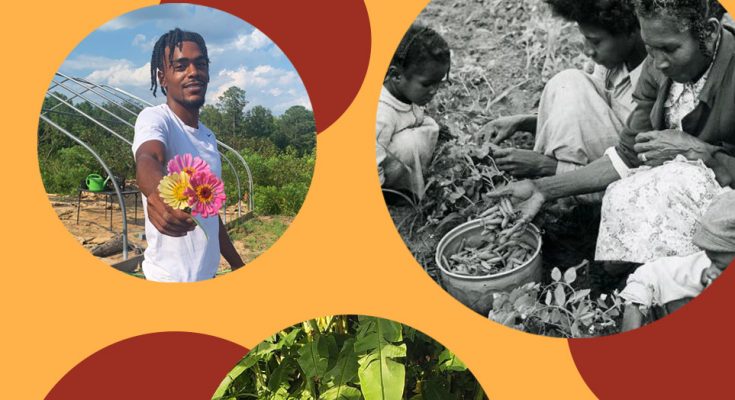Racial discrimination has long contributed to the steady decline of Black-owned farms in America, but a movement to grow those numbers may soon be bolstered by real support
by Nadra Nittle Feb 23, 2021, 10:30am EST
African-American farmers are disappearing.
The legacy of structural inequality has steadily depleted their ranks. For nearly a century, racial discrimination in agriculture, exclusion from federal relief programs, and laws that preyed upon the economically disadvantaged have slashed the number of Black farmers in America from the nearly 1 million who farmed in 1920 to fewer than 50,000 today. This systemic dispossession of acreage and wealth makes farms like Julius Tillery’s in Northampton County, North Carolina, increasingly scarce.
Born into freedom in 1871, Tillery’s great-great-grandfather became the first farm owner in his family. Hog farming in North Carolina dates back to Colonial times, so the farm included pigs from the outset as well as crops like cotton, soybeans, peanuts, and corn. Across generations, the family resisted “this notion of moving away from farming to make more money in town… or wanting to get a more white-collar job,” says Tillery, who, as the North Carolina state coordinator for the Black Family Land Trust, helps African Americans preserve their land, pursue land ownership, and farm sustainably. “My dad grew up farming, and his dad was farming, and my great-grandfather farmed, so we’ve always stayed in the business.”
But for Tillery, the past year in agriculture has run the gamut “from extremely high highs to some low lows.” His company Black Cotton, which sells cotton jewelry, accessories, and home decor, garnered unprecedented attention following the calls to support Black businesses in the wake of Black Lives Matter protests. But shipping delays, supply shortages, and the need to suspend travel to vendor markets to avoid contracting COVID-19 cost him opportunities to expand his clientele, sell more goods, and showcase his products to new audiences. To enforce social distancing, Tillery also hired fewer farmworkers last year. Although he and his father planted what they could, a larger team could have planted more crops, which, in addition to cotton, include soybeans and green leafy vegetables on 125 acres. Tillery recently lamented that he was “land rich but cash poor.”
Although farming can be a thankless industry, Tillery contends that the hard work is worth it. “It takes sacrifice to really be able to hold on to land,” he says.
For a once-enslaved people forced to work the land of their oppressors, landownership has always symbolized freedom. Black farm owners argue that possessing land enables them to be their own boss, grow their own food, and live on property they control. Historically, farming catapulted some African Americans squarely into the middle class, including jazz legend Miles Davis, a farmer’s son. And during the civil rights movement, Black farm owners allowed activists to use their properties to organize; they often fought for racial equality themselves.
Today, achieving autonomy though farmland acquisition is an experience familiar to few African Americans. White landowners possess 98 percent of all farmland, and 95 percent of farmers are white, according to a report from the National Young Farmers Coalition (NYFC). The events of the past year have only made things more difficult. Through 2020, Black farmers have fought to retain their farmland amid discrimination from the federal government, mass commercialization of agriculture, racial violence, economic instability, and, now, a pandemic.
At the start of 2020, the United States agriculture industry was still reeling from the effects of former President Donald Trump’s 2018 trade war with China. After Trump raised tariffs on Chinese imports, China responded with retaliatory tariffs on the U.S.’s agricultural exports, which caused the cost of American agricultural commodities to drop and led to a decline in soybeans and other exports. These developments, along with higher farm machinery costs as equipment grows larger and more technologically advanced, reduced net farm income by 16 percent during the trade war’s first year.
:no_upscale()/cdn.vox-cdn.com/uploads/chorus_asset/file/22316420/BlackCotton_JuliusTillery.jpg)
All kinds of American farmers felt the impact of the revenge tariffs, but when the pandemic hit — causing global shutdowns that evaporated consumer bases and disrupting the food supply chain — Black farmers in particular lacked a safety net. According to a report from the Counter, white business owners received 99.5 percent of the subsidies designed to help farmers survive the trade war. And although Trump handed out record subsidies to help farmers rebound from COVID-19, African Americans in agriculture largely didn’t receive these monies. For the most part, Black farmers did not obtain federal Paycheck Protection Program (PPP) and Coronavirus Food Assistance Program (CFAP) aid designed to help businesses weather the pandemic.
“We’re holding on by a thread here,” says National Black Farmers Association (NBFA) president John Boyd Jr., whose organization includes 116,000 members, including farmers, landowners, and advocates in 42 states. “We [Black farmers] didn’t really fit into a lot of the relief programs. The PPP — they tried to say we weren’t eligible for that. And a lot of the payment programs that the Trump administration rolled out didn’t seem to find their ways to Black farmers. … It was a really painful year.” Critics of these programs say the multibillion-dollar efforts bailed out large and well-connected farm owners while excluding the small farm owners, Black or otherwise, most in need of help.
The lack of federal relief for Black farmers amplified the stresses they’ve contended with during the pandemic. “The cattle markets, the livestock markets, were closed,” says Boyd, a fourth-generation beef cattle and grain farmer. Grain elevators closed, which Boyd says he’s “never seen” happen before during a harvest, meaning that crops normally stored in these facilities instead remained in the field, lowering the grain’s quality and costing farmers money. “And soybeans went down to about $7 a bushel; corn and wheat hovered around $3 a bushel,” Boyd says. “These were unseen times in America, and I’ve been farming since 1983.”
As the coronavirus interfered with day-to-day operations, access to credit dried up for farmers, Boyd says. With a 1,300-acre operation in Baskerville, Virginia, Boyd is fortunate to have a farm that’s 10 times the size of the average Black-owned farm, but last year marked the first time he didn’t have a farm operating loan. Farmers can use these usually short-term loans to cover everything from livestock, seed, and equipment to farm operating costs and family living expenses; farmers usually borrow on a year-long basis to cover annual expenses, and pay it back after harvest. Boyd was forced to use his own credit cards to keep his business afloat. He blames the “devastating” turn of events on the nation’s leading financial institutions and the USDA refusing to meet the needs of African-American farmers during times of crisis.Racial discrimination in agriculture has long locked African-American farmers out of the support they sorely need. It’s a longstanding pattern.
Black farmers struggle to compete with their white counterparts when they don’t have equal access to federal relief, but there are a confluence of factors that prevent them from gaining equal footing in agriculture. Having fewer industry connections, less access to credit, and smaller farms makes it difficult for African-American farm owners to improve machinery, modernize, or expand, all of which would generate more revenue. Smaller revenues make it harder to qualify for the financial assistance that could give their farms a competitive edge. What’s more, racial discrimination in agriculture has long locked African-American farmers out of the support they sorely need, contributing to the demise of Black-owned farms across the country.
It’s a longstanding pattern. During the 1930s, structural racism began to erode the gains of African Americans who had toiled and sacrificed to acquire their own farmland as newly liberated people after the Civil War. “Farmers of color … were left out of a lot of these policies that supported farmers following the Great Depression and the Dust Bowl, when it was a really challenging time to be a farmer, as it always has been,” says Holly Rippon-Butler, NYFC’s land access program director. “The fact that these programs left out farmers of color, and Black farmers in particular, led to a … really sharp decline in the number of Black farmers that’s disproportionate to white farmers at the same time period.”
The New Deal, the set of public works programs, financial reforms, and other policies President Franklin D. Roosevelt implemented to help the country bounce back from the Great Depression, established the Agricultural Adjustment Administration (AAA) to offset the effects of the economic downturn on the agriculture sector. The AAA organized committees that controlled agriculture in counties across the country, according to historian Pete Daniel, author of Dispossession: Discrimination Against African American Farmers in the Age of Civil Rights. White power brokers who were primarily interested in amassing more farmland for themselves (or for others who shared their racial and class backgrounds) made up the bulk of these committees. They ignored or antagonized African-American farmers, who were excluded from serving on the committees and lacked the resources to challenge the decisions of the all-white members bent on limiting the amount of crops they could grow.
:no_upscale()/cdn.vox-cdn.com/uploads/chorus_asset/file/22319233/BlackCotton_JuliusTillery_copy.jpg)
“In those days, there were allotments for crops, for example, cotton,” Daniel says. “Each farm owner was given so many acres to grow. If you were an African-American farmer, white people could just cut you right down to nothing.” In short, the powerful individuals who served on the county AAA committees could allot African Americans significantly less land to cultivate than they allotted to whites, allowing white farmers to thrive while curtailing Black progress in agriculture.
Officials at the USDA’s now-defunct Farmers Home Administration (FHA), founded in 1946, also engaged in discrimination, namely by denying loans to Black farmers. By withholding the financial resources these farmers needed and limiting the crops they could grow, officials at various levels of government made it difficult for African Americans in agriculture to flourish.
State laws directly served to separate Black farmers from their land as well. For example, many Southern states had (and still have) heirs’ property laws that took effect when landowners died without wills, rendering the decedents’ heirs owners of a fractional interest in their property. The number of heirs multiplied with each new generation, and any of them could sell their fractional interest or ask a court to force a sale of the property, even if the other heirs objected. But historic barriers to legal services mean that as many as 50 to 75 percent of African Americans die without wills, causing them to lose farmland. Although heirs’ property is worth an estimated $28 billion in the South, court-ordered sales of this property, often to white buyers, have resulted in it being purchased for “pennies on the dollar.”
Heirs’ property laws and loan denials continued to plague African-American farmers well into the 20th century. In 1997, Boyd participated in Pigford v. Glickman, a class action lawsuit against the USDA for discriminating against Black farmers seeking loans and support from the agency between 1981 and 1996. The government settled the case for $1 billion two years later. Boyd took part in the lawsuit after FHA officials repeatedly turned him down for small loans while granting sizable loans to white farmers in his region. On more than one occasion, FHA officers reportedly engaged in overt racism, including spitting on Boyd and tossing his loan application in the trash without reviewing it. He launched the NBFA after connecting with other Black farmers who’d endured similar ordeals.
Winning the Pigford case proved bittersweet. A number of the Black farmers who’d experienced racial discrimination while applying for USDA support were already dangerously in debt or unaware of the class action suit when the federal government disbursed $62,500 apiece to the 400 farmers represented. Some lost their farms or died before receiving the settlement, but the NBFA’s ongoing advocacy prompted then-President Barack Obama to sign a bill in 2010 approving a $1.25 billion payout, known as Pigford II, to the Black farmers excluded from the original class action. Neither settlement, however, could help the African Americans who lost an estimated 36 million acres of farmland from 1920 to 1978 because of systemic racism.
:no_upscale()/cdn.vox-cdn.com/uploads/chorus_asset/file/22316429/asaud_frazier1.jpg)
“Pigford did things in that people got money, but you can’t possibly atone for the racial discrimination that happened in the ’50s, ’60s, and ’70s,” Daniel says. “You can’t bring back those farmers to the land. They’re gone. The people in that case endured even after all that discrimination, but it was tough.”
And it isn’t over. Black farmers today say they experience bias in the public and private sectors alike. As the coronavirus rocked agriculture in 2020, the NBFA continued to call out discrimination, initiating a boycott against agriculture equipment manufacturer John Deere. The group alleges that the company does not respond to Black farmers’ calls for service on its machinery in a timely manner and remotely shuts off tractors when these farmers try to repair equipment on their own. Additionally, NBFA accused John Deere of refusing to exhibit its products at the NBFA’s annual conference. More detrimental, Boyd believes John Deere has made it difficult for African Americans, who must often rely on their own financial resources and not federal loans, to buy equipment.
“The issue with John Deere is that many Blacks are C.O.D. [cash on delivery] borrowers, and we don’t have credit there,” Boyd says. “They’re [one of] the largest agricultural lenders in the world, and when you don’t extend credit to somebody, we can’t get the equipment … unless we have cash money to do that.”
A John Deere spokesman says that it takes Boyd’s allegations seriously and is “committed to eliminating the systemic inequities that have prevented generations of Black Americans and communities of color from having fair access to social and economic opportunities.” The representative notes that the company recently joined a new coalition with the National Black Growers Council, the Thurgood Marshall College Fund, and the Federation of Southern Cooperatives to help Black farmers overcome systemic challenges.
For hemp farmer Asaud Frazier, getting a tractor, be it from John Deere or another manufacturer, is a top priority. The 28-year-old just launched his Alabama farm last May, two months into the nation’s coronavirus pandemic. His family spent years combing through paperwork to prove they were the rightful heirs to land that had lain fallow since an ancestor bought it in the 1920s. But after winning legal challenges brought by others who tried to claim the land as their own, hiring contractors willing to help him cultivate the 40 acres proved nearly impossible. After multiple contractors abandoned him during the pandemic, Frazier managed to find one to drill a well, connect electricity and water to his greenhouse, and loan him a much-needed tractor. So far, he’s cultivated five acres of hemp.
Although the USDA offers small-farm operating and ownership loans to beginning farmers, Frazier says his application was unsuccessful because he’s starting out with too few resources to qualify. So, as he builds his farm from the ground up, he does so without federal financial help.
“A lot of the USDA programs for beginning farmers aren’t really for true beginner farmers like myself getting started on virgin land,” says Frazier, who earned a bachelor’s degree and a master’s degree in environmental science and plant science, respectively, from Tuskegee University. “For instance, if I want to get a fence for my farm through the USDA, I already have to have … so many acres of fencing to qualify for that. … If I want to get a well for water put on my property, I already need to have animals out … grazing on my land.”
:no_upscale()/cdn.vox-cdn.com/uploads/chorus_asset/file/22319287/sanofka_bees.jpg)
:no_upscale()/cdn.vox-cdn.com/uploads/chorus_asset/file/22319254/Sanofka_whellbarrow.jpg)
When Frazier didn’t receive the support he needed from the agency, his family pooled their resources to help him begin the work to get his farm up and running, though he has not yet purchased a tractor of his own. “It felt great; that was one of the success stories of 2020,” Frazier says. “I felt a sense of liberation, and I feel like this goes back to the whole movement of Black people wanting to get back to the land. … It’s really a great time.”
The movement of African Americans reclaiming their “oldest occupation,” as Boyd puts it, may soon be bolstered by real support. On February 8, Sen. Cory Booker (D-New Jersey) reintroduced legislation in the Senate that seeks to give Black farmers the training, financial resources, and farmland they need to succeed, while Sen. Rev. Raphael Warnock (D-Georgia) introduced legislation to provide $5 billion in assistance to farmers of color, including African Americans, Hispanic Americans, and Native Americans.
Warnock would like his Emergency Relief for Farmers of Color Act to be folded into President Joe Biden’s $1.9 trillion coronavirus relief package that’s now making its way through Congress. And Booker’s Justice for Black Farmers Act has the potential to usher in a new era in agriculture: The landmark legislation would create an independent civil rights oversight board to end racial discrimination in the USDA and start a program within the agency to give existing and aspiring Black farmers equitable access to land. If enacted, the legislation would also provide young adults from disadvantaged communities with skills to pursue farming and ranching careers and fund a new bank to support Black farmers and ranchers. Notably, Justice for Black Farmers would forgive the USDA debt of the African Americans who filed claims in the Pigford lawsuit.
Advocates for Black farmers have applauded both bills, arguing that even if this ambitious legislation doesn’t get passed, it has the capacity to raise public awareness about the struggles of African Americans in agriculture historically and today, which could eventually lead to policy change.
According to the National Young Farmers Coalition, access to farmland is the top barrier facing aspiring farmers, even now. In 2019, the staff of Fresh Future Farm in North Charleston, South Carolina, raised $75,000 to buy the less than an acre of land they lease from the city to run the urban farm and an accompanying USDA-designated grocery store; they’re still in talks with North Charleston’s city leaders about the possible sale. “It’s very difficult for a farm to thrive if you don’t own the land, which is our struggle right now,” co-founder Germaine Jenkins says. Jenkins is a culinary school grad who first took an interest in farming nearly 20 years ago, after experiencing “food apartheid” while mothering young children. She hopes to one day acquire land throughout the city. If the Justice for Black Farmers Act passes, it would help farmers like her access up to 160 acres through a USDA land-grant system.
But rather than any one piece of legislation, many Black farmers are hopeful about the new Biden-Harris administration, particularly that the nation’s new leaders will be more willing to act on their concerns than their predecessors were. During his transition to the White House, Biden announced plans to “ensure the U.S. Department of Agriculture ends historical discrimination against Black farmers.”
And if Black farmers don’t see results from the Biden administration, Boyd says they’re prepared to hold it accountable. Having fought against injustice for generations, these farmers are accustomed to self-advocacy and want to ensure that they receive federal relief in greater numbers. “If we don’t start getting this money, we’re going to become extinct,” Boyd says. “That’s where the focus of the National Black Farmers Association is going to be this year.”“There needs to be an intentional effort to support the growth of Black farms.”
Although Boyd doesn’t doubt that the new administration will at least attempt to meet the needs of Black farmers, Biden’s decision to choose Tom Vilsack as the U.S. secretary of agriculture has raised concerns from critics who argue that he had a poor civil rights record when he held the same post in the Obama-Biden administration. In 2015, for example, Black farmers received less than 0.2 percent of the $5.7 billion loans available under a Vilsack-led USDA. And during his tenure, Vilsack forced African-American Shirley Sherrod, former state director of USDA rural development in Georgia, to step down after a conservative news outlet doctored a video to suggest that she discriminated against white farmers. Sherrod recently said that she holds “no ill will” toward Vilsack, but that this time around, he “definitely needs to pay more attention to family farmers, and especially African-American farmers.”
Boyd points out that African Americans in agriculture have struggled during both Democratic and Republican administrations. Because of this, they have long taken the initiative to address the needs of their communities — from providing fresh produce to food-insecure neighborhoods to preparing the next generation of African Americans for agricultural careers.
When the pandemic forced most of the nation to lock down, Fresh Future Farm received grants and donations to give groceries to vulnerable community members on a bimonthly basis. And in light of the Justice for Black Farmers Act, the organization launched the Black Farmers Coalition for South Carolina. “I see where there are resources available for farmers at the state level, and the recipients of those resources tend to be white,” Jenkins says. “There needs to be equity in how agriculture resources and land are distributed in that there needs to be an intentional effort to support the growth of Black farms.”
Since the average Black farmer is older than 60, Jenkins particularly wants to engage young African Americans in agriculture. It’s a goal that Kamal Bell, chief executive officer of North Carolina’s Sankofa Farms, shares.
With a master’s degree in agricultural education from North Carolina A&T University and middle school teaching experience, Bell launched the Sankofa Farms Agricultural Academy with the goal of improving the perception of STEM and agriculture professions. The academy now includes six students. “We’ve been able to produce food for our community, and we also have an education piece where these young men have learned about STEM concepts, entrepreneurship, and how to grow the food, so they’re really taking control over their own destiny,” Bell says. During the pandemic, Sankofa, which produces honey and grows watermelons, squash, leafy greens, and other vegetables, has been able to source all of the supplies it needs. Bell attributes this success to his involvement in organizations like the Rural Advancement Foundation International’s Farmers of Color Network, which assists farmers from marginalized groups.
Having launched NBFA to support a similar population of farmers, Boyd has learned to dictate his own fate. “For people who want to count us out, I’m going to die a farmer,” Boyd says. “No discrimination is going to stop me from putting my plow in the ground. No policy is going to stop me from putting my plow in the ground. That’s the determination that we have to have to survive in this country.”
Nadra Nittle is a senior reporter for Civil Eats. She lives in Los Angeles.
Lead image photo credits: Asaud Frazier, Fresh Future Farms, Marion Post Walcott, NYPL Digital Collections




